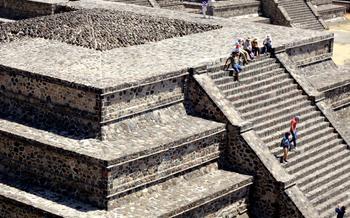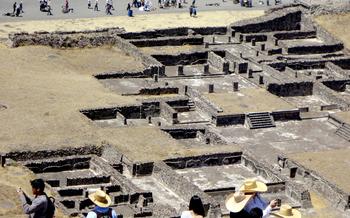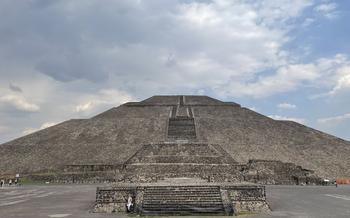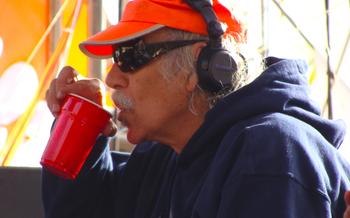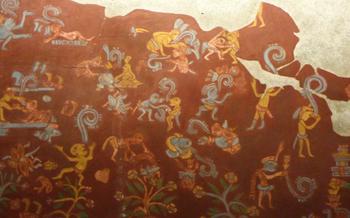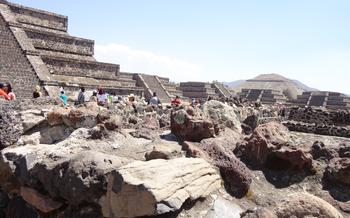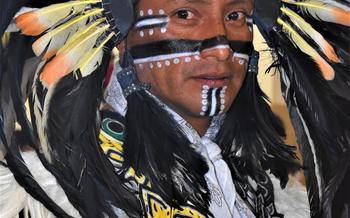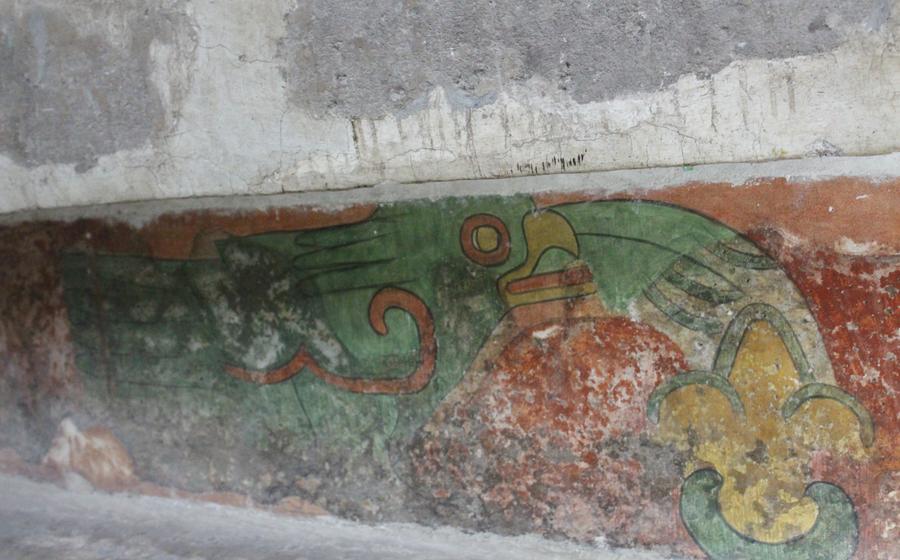
Los Jaguares Palace
- Los Jaguares Palace: A Stunning Masterpiece
- Location and Accessibility
- Unveiling the History of Los Jaguares Palace
- Exploring the Palace's Architectural Marvels
- Immerse in the Beauty of Murals and Artwork
- Unveiling the Mysteries of Teotihuacan Society
- Tips for an Enriching Visit
- Delving into the Palace's Symbolism
- Interactive Displays and Exhibitions
- Exploring Beyond the Palace: Nearby Attractions
- Additional Historical Context: Teotihuacan's Legacy
- Sustainability and Conservation Efforts
- Engaging with Local Culture: Festivals and Events
- Unforgettable Photo Opportunities
- Insider Tip: Unveiling the Hidden Gem
Los Jaguares Palace: A Stunning Masterpiece
In the heart of Teotihuacan, Mexico, lies a magnificent architectural wonder known as Los Jaguares Palace. This awe-inspiring palace, built by the ancient Teotihuacans, stands as a testament to their remarkable artistry and ingenuity. Its name, derived from the vibrant jaguar murals adorning its walls, hints at the grandeur and significance it held in Teotihuacan society. Constructed around the 5th century AD, Los Jaguares Palace served as a royal residence, an administrative center, and a sacred ceremonial site, showcasing the city's political, economic, and spiritual power.
The palace's architectural design is a masterpiece of precision and symmetry, featuring a series of interconnected rooms and courtyards arranged around a central plaza. Its walls are adorned with intricate murals depicting gods, animals, and mythical creatures, offering a glimpse into the rich mythology and beliefs of the Teotihuacans. The palace's grandeur and artistic splendor make it one of the most captivating landmarks in Teotihuacan, inviting visitors to delve into the depths of this ancient civilization.
Location and Accessibility
Los Jaguares Palace proudly stands within the archaeological zone of Teotihuacan, just 48 kilometers northeast of Mexico City. This ancient metropolis, declared a UNESCO World Heritage Site, offers a glimpse into the remarkable pre-Columbian civilization that flourished in central Mexico. To reach the palace, visitors can embark on a scenic drive along the well-maintained highways, immersing themselves in the captivating landscape dotted with majestic pyramids and ancient ruins. Upon arrival, ample parking facilities are available, ensuring a hassle-free visit. Teotihuacan's strategic location makes it easily accessible, providing a convenient and rewarding journey through time.
Unveiling the History of Los Jaguares Palace
The construction of Los Jaguares Palace is estimated to have taken place around the 5th century AD, during the height of Teotihuacan's power and influence. It is believed to have served as a royal residence for the city's rulers and their families, as well as a center for administrative and ceremonial activities. The palace's size, grandeur, and elaborate decorations suggest its importance as a symbol of authority and prestige within Teotihuacan society.
Archaeological excavations have revealed that the palace was constructed in several stages, with additions and modifications made over time. The original structure consisted of a central courtyard surrounded by several rooms, including living quarters, storage spaces, and ceremonial chambers. As the city grew and prospered, the palace was expanded to include additional courtyards, corridors, and rooms, creating a sprawling complex that covered an area of several acres.
The inhabitants of Los Jaguares Palace likely led a life of luxury and privilege. They enjoyed access to the finest foods, clothing, and goods that Teotihuacan had to offer. They were also responsible for overseeing the city's administration, conducting religious rituals, and maintaining diplomatic relations with other regions. The palace was a hub of activity, where merchants, artisans, and officials from all corners of the empire came to conduct business and pay homage to the city's rulers.
Ongoing archaeological research at Los Jaguares Palace continues to shed light on the daily lives of its ancient inhabitants. Recent excavations have uncovered evidence of workshops where artisans produced exquisite jewelry, pottery, and textiles. Archaeologists have also discovered the remains of kitchens, dining areas, and bathing facilities, providing insights into the domestic aspects of life within the palace.
Exploring the Palace's Architectural Marvels
The Los Jaguares Palace showcases the remarkable architectural prowess of the Teotihuacan civilization. Constructed predominantly using adobe bricks, the palace exhibits intricate construction techniques and a unique style that sets it apart from other structures in the city. Visitors can admire the precision and symmetry of the palace's layout, which aligns with celestial events such as the solstices and equinoxes. The palace's design incorporates various symbolic elements, such as the jaguar motif, which holds significant cultural and religious importance in Teotihuacan society. These elements add depth and meaning to the palace's architecture, inviting visitors to unravel the hidden stories and symbolism embedded within its walls.
Immerse in the Beauty of Murals and Artwork
The walls of the Los Jaguares Palace are adorned with vibrant murals and artwork that captivate visitors with their intricate details and vivid colors. These murals provide a glimpse into the cultural and religious beliefs of the Teotihuacan people. They depict gods, animals, and mythical creatures, each holding symbolic meaning and narrating stories from their ancient mythology.
The murals showcase the artistic prowess of the Teotihuacan artists. They used a variety of techniques, including fresco and tempera, to create these masterpieces. The colors have remained remarkably well-preserved over time, thanks to the dry climate of the region.
One of the most striking murals is the "Procession of the Jaguars," which depicts a line of jaguars walking in a single file. The jaguars are adorned with elaborate headdresses and jewelry, symbolizing their importance in Teotihuacan society. Another notable mural is the "Goddess of Water," which portrays a female deity associated with fertility and agriculture.
The murals in the Los Jaguares Palace offer a window into the minds and beliefs of the Teotihuacan people. They provide valuable insights into their religious practices, social structure, and cultural traditions.
Unveiling the Mysteries of Teotihuacan Society
Los Jaguares Palace provides a glimpse into the intricate social structure and cultural practices of the Teotihuacan civilization. Archaeologists believe that the palace served as a residence for elite members of society, possibly even the rulers themselves. The elaborate murals and artwork depict scenes of daily life, religious rituals, and mythological stories, offering valuable insights into the beliefs and customs of the Teotihuacan people.
The palace's architecture and layout suggest a hierarchical society with distinct social classes. The elaborate decoration and luxurious furnishings of the palace's interior indicate the wealth and power of the ruling class. In contrast, the more modest dwellings found outside the palace walls suggest that the majority of the population lived in simpler conditions.
The murals and artwork within the palace provide clues about the economic activities and trade networks of the Teotihuacan civilization. Depictions of merchants and traders carrying exotic goods suggest that Teotihuacan was a major hub for commerce and trade. The discovery of obsidian tools and other artifacts from distant regions indicates that the Teotihuacan people had extensive trade relations with other Mesoamerican societies.
The palace also played a significant role in the religious life of the Teotihuacan people. Murals depicting gods, goddesses, and mythical creatures suggest that the palace was a site for religious ceremonies and rituals. Archaeologists have discovered evidence of offerings and sacrifices made within the palace, further supporting the notion that it was a sacred space.
By studying the Los Jaguares Palace, archaeologists and historians have gained valuable insights into the social structure, economic activities, religious beliefs, and daily lives of the Teotihuacan people. This magnificent palace stands as a testament to the complexity and sophistication of one of Mesoamerica's most influential civilizations.
Tips for an Enriching Visit
To fully appreciate the wonders of Los Jaguares Palace, plan your visit wisely and come prepared.
-
Optimal Timing: Aim to visit during the shoulder seasons (April-May and September-October) for pleasant weather and fewer crowds. Avoid peak tourist season (November-March) unless you prefer a lively atmosphere.
-
Wardrobe and Essentials: Dress comfortably in breathable clothing suitable for walking on uneven surfaces. Bring a hat, sunscreen, and sunglasses to protect yourself from the sun. Carry water and snacks, as food options within the site are limited.
-
Guided Tours: Enhance your experience by joining a guided tour led by knowledgeable experts. These tours provide in-depth insights into the palace's history, culture, and symbolism. Audio guides are also available for self-guided exploration.
-
Photography Guidelines: Photography is generally permitted within the palace, but flash photography is prohibited to preserve the delicate murals. Respect the guidelines and avoid using tripods or selfie sticks that may obstruct other visitors' views.
Delving into the Palace's Symbolism
The Los Jaguares Palace is a treasure trove of symbolic imagery, reflecting the complex beliefs and cultural identity of the Teotihuacan civilization. Sacred symbols and motifs adorn the palace walls, each carrying deep meaning and significance. Jaguars, revered as powerful and majestic creatures, are a recurring motif, representing rulership, strength, and the divine connection between the earthly and spiritual realms.
Cosmic symbolism is also prevalent, with alignments between the palace's architecture and celestial events. The palace's orientation and positioning suggest an understanding of astronomical phenomena, aligning with the movements of the sun, moon, and stars. These alignments served as a calendar system, guiding agricultural practices and religious rituals.
The intricate symbolism of the Los Jaguares Palace provides a glimpse into the sophisticated worldview of the Teotihuacan people. Their beliefs, rituals, and connection to the cosmos are woven into the fabric of the palace's design, creating a sacred and awe-inspiring space that continues to captivate visitors to this day.
Interactive Displays and Exhibitions
Los Jaguares Palace showcases innovative exhibits that bring Teotihuacan's history and culture to life. Interactive displays engage visitors of all ages, providing a comprehensive understanding of this ancient civilization. Multimedia presentations, virtual reality experiences, and hands-on activities make learning about Teotihuacan a dynamic and immersive experience. Interactive maps and guides facilitate self-guided exploration, allowing visitors to delve deeper into the palace's secrets at their own pace. These interactive elements enhance the overall experience, making a visit to Los Jaguares Palace not just an educational journey but also an entertaining and memorable adventure.
Exploring Beyond the Palace: Nearby Attractions
While Los Jaguares Palace stands as a captivating highlight, Teotihuacan offers a wealth of additional attractions to delve into. The iconic Pyramid of the Sun and Pyramid of the Moon are awe-inspiring structures that showcase the city's architectural prowess. Explore the Ciudadela complex, a vast plaza surrounded by impressive structures, including the Temple of Quetzalcoatl. Immerse yourself in the Teotihuacan Museum, housing a remarkable collection of artifacts and exhibits that shed light on the city's history and culture.
Venture beyond the archaeological site to the nearby city of San Juan Teotihuacan and soak in its vibrant atmosphere. Stroll through the colorful streets lined with traditional Mexican restaurants, cafes, and craft shops. Browse the vibrant Mercado de Artesanías for authentic souvenirs, including intricate pottery, handwoven textiles, and colorful alebrijes figures. Indulge in the flavors of traditional Mexican cuisine at local eateries, savoring the aromatic delights of dishes like barbacoa, mole, and freshly made tortillas.
Uncover the essence of Teotihuacan's rich heritage by engaging with the local community. Attend one of the many festivals and events held throughout the year, where you can witness traditional dance performances, admire local artisans showcasing their crafts, and immerse yourself in the infectious energy of the celebrations. These events offer invaluable opportunities to connect with the friendly locals and gain a deeper understanding of their customs and traditions.
Additional Historical Context: Teotihuacan's Legacy
Teotihuacan's legacy extends far beyond its physical remains. The city's influence on Mesoamerican cultures was profound and long-lasting. Teotihuacan's advanced knowledge of astronomy, mathematics, and architecture was adopted and adapted by subsequent civilizations throughout the region. Trade routes established by the Teotihuacans facilitated cultural exchange and the spread of ideas, leading to the development of complex societies across Mesoamerica.
Despite their remarkable achievements, the Teotihuacans eventually disappeared, leaving behind a mystery that continues to captivate scholars and historians. The reasons for their decline are still debated, with theories ranging from climate change and environmental degradation to internal political strife and external invasions. The sudden and unexplained nature of their disappearance has fueled speculation about catastrophic events or divine intervention.
Archaeological discoveries at Teotihuacan have shed light on the city's complex social structure, elaborate religious beliefs, and sophisticated urban planning. The city's grid-like layout, monumental architecture, and sophisticated water management system demonstrate the advanced level of engineering and urban design achieved by the Teotihuacans. The discovery of rich burials and elaborate offerings has provided insights into their religious practices and beliefs in an afterlife.
Teotihuacan's legacy continues to inspire and fascinate people worldwide. Its iconic pyramids, vibrant murals, and enigmatic history make it a must-visit destination for anyone interested in ancient civilizations and cultural heritage. The city's enduring influence and the mysteries surrounding its rise and fall serve as a reminder of the rich and complex history of Mesoamerica and the enduring power of human creativity and innovation.
Sustainability and Conservation Efforts
Teotihuacan's rich cultural heritage is not only a source of fascination for visitors but also a symbol of Mexico's national identity. Preserving this priceless legacy requires a concerted effort to balance tourism with sustainability. The Mexican government, in collaboration with UNESCO, has implemented several initiatives to protect and conserve this ancient city.
Environmental sustainability is a top priority, with measures in place to minimize the ecological impact of tourism. Waste management systems, recycling programs, and the use of renewable energy sources are actively promoted. Visitors are encouraged to adopt responsible behaviors, such as reducing plastic waste and respecting the natural surroundings.
Conservation efforts focus on preserving and restoring Teotihuacan's architectural marvels. Ongoing archaeological projects meticulously uncover new sections of the city, shedding light on its past while ensuring the integrity of the remaining structures. Restoration work is carried out using traditional techniques and materials, respecting the original design and craftsmanship.
Eco-friendly accommodations and tour operators are emerging to cater to conscious travelers. These businesses prioritize sustainable practices, such as using local resources, minimizing carbon emissions, and supporting community-based tourism initiatives. By choosing these options, visitors can contribute to the preservation of Teotihuacan while enjoying an authentic and immersive experience.
Engaging with Local Culture: Festivals and Events
Teotihuacan is not only about ancient ruins and historical marvels; it's also a vibrant hub of local culture and traditions. Throughout the year, the city hosts a variety of festivals and events that offer visitors a chance to immerse themselves in the rich cultural heritage of the region.
One of the most significant events is the annual Festival de la Muerte (Day of the Dead), held every November. During this festival, the city comes alive with colorful decorations, traditional music, and elaborate altars honoring the deceased. Visitors can witness parades, costume contests, and other festivities that celebrate the unique Mexican tradition of remembering and honoring their ancestors.
Another popular event is the Feria de San Juan Teotihuacan, held in June. This lively fair features traditional dance performances, music shows, and a vibrant market where local artisans showcase their handmade crafts and products. Visitors can indulge in delicious local cuisine, enjoy live music, and experience the infectious energy of this cultural extravaganza.
Engaging with local festivals and events in Teotihuacan is an exceptional opportunity to connect with the community, learn about their traditions, and appreciate the vibrant cultural tapestry of this ancient city.
Unforgettable Photo Opportunities
Los Jaguares Palace offers a treasure trove of photo opportunities, allowing visitors to capture the essence of Teotihuacan's grandeur. The palace's impressive architecture, vibrant murals, and intricate artwork provide a stunning backdrop for memorable shots.
The central courtyard, with its towering columns and symmetrical layout, is a popular spot for panoramic shots. The murals adorning the palace walls, depicting gods, jaguars, and mythical creatures, are a photographer's delight, showcasing the vibrant colors and intricate details of Teotihuacan art.
For a unique perspective, climb to the upper levels of the palace to capture elevated shots of the surrounding complex and the vast expanse of Teotihuacan beyond. The terraces and balconies offer breathtaking views, perfect for capturing the scale and majesty of this ancient city.
Remember to bring a wide-angle lens to capture the grandeur of the palace's architecture and a macro lens to zoom in on the intricate details of the murals. A tripod can also be useful for stabilizing your camera for sharp shots, especially in low-light conditions.
Drone photography is allowed at Teotihuacan, but be sure to follow the regulations and guidelines to ensure responsible and respectful flying. Adhere to designated drone zones and avoid flying near crowds or sensitive areas.
To capture Instagrammable shots, look for unique angles and perspectives that showcase the palace's distinctive features. Experiment with different lighting conditions, such as golden hour or sunset, to create dramatic and atmospheric photos.
Insider Tip: Unveiling the Hidden Gem
Amidst the grandeur of Los Jaguares Palace, there lies a hidden gem that often goes unnoticed by visitors. Tucked away from the main thoroughfares, this secluded section of the palace holds secrets waiting to be uncovered.
To access this hidden realm, look for a discreet entrance concealed among the intricate carvings adorning the palace walls. As you step inside, you'll find yourself in a labyrinth of narrow corridors and dimly lit chambers. The air is thick with mystery and intrigue, inviting you on a journey through time.
These hidden spaces once served as private chambers for the palace's elite residents. Adorned with exquisite murals and intricate artwork, they offer a glimpse into the lives of the ancient Teotihuacan people. Explore these rooms to discover hidden alcoves, secret passageways, and forgotten artifacts that tell tales of power, intrigue, and ancient rituals.
Unveiling this hidden gem is like embarking on a treasure hunt, where each discovery brings you closer to understanding the enigmatic world of Teotihuacan. It's an experience that will leave you with a profound appreciation for the palace's rich history and cultural significance.
